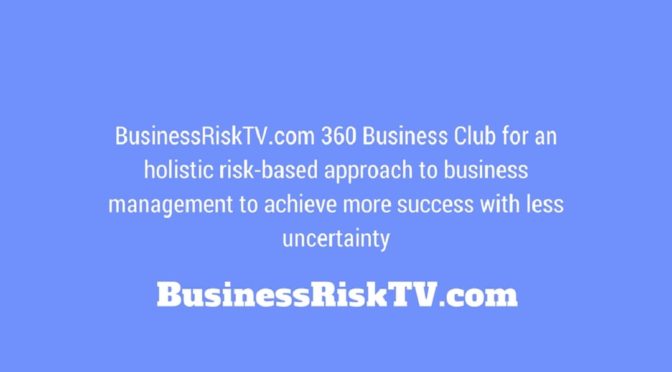Subscribe to BusinessRiskTV for free alerts and bulletins to your email inbox on practical ways to improve your business performance
Setting the wrong business strategy can destroy your great business. Enterprise risk management principles and practices will help you understand your business risks better. Improve your business risk management strategy with BusinessRiskTV.

Inform your business decision making process
Make better business decisions more often with less uncertainty.

Promote and market your business more profitably for 12 months

Read risk management articles and watch videostream trending on BusinessRiskTV
Guide To Problem Solving With BusinessRiskTV
Common Biz Problems & Solutions
Common Business Problems: Impediments and the BusinessRiskTV Guide to Problem Solving
Running a business is an intricate endeavour filled with various challenges. From startup ventures to well-established corporations, businesses face a range of problems that can hinder their growth, profitability, and overall success. Recognising and addressing these issues promptly is crucial to ensure the longevity and prosperity of any organisation. In this article, we will explore some common business problems, discuss why they impede businesses, and present the BusinessRiskTV Guide to Problem Solving.
I. Financial Constraints
One of the most prevalent issues faced by businesses is financial constraints. Limited access to capital, cash flow problems, and high operating costs can cripple an organisation’s ability to invest, expand, and innovate. Insufficient funding can prevent businesses from hiring top talent, acquiring necessary resources, and adapting to market changes. Without a strong financial foundation, companies may struggle to remain competitive and sustain their operations in the long run.
II. Lack of Innovation
Innovation is vital for businesses to stay relevant and competitive in today’s dynamic market. However, many organisations face the challenge of stagnation and a lack of innovation. This problem can arise due to a rigid organisational structure, resistance to change, or a failure to allocate resources for research and development. Without a focus on innovation, businesses may fail to keep up with evolving customer demands and technological advancements, ultimately losing their competitive edge.
III. Ineffective Marketing and Branding
Marketing and branding play a significant role in shaping a business’s perception among consumers. However, many companies struggle with developing effective marketing strategies and building a strong brand identity. Inadequate market research, ineffective communication, and a lack of brand consistency can lead to low customer engagement, reduced sales, and difficulty in attracting new customers. Without a robust marketing and branding approach, businesses may fail to differentiate themselves from competitors and struggle to establish a loyal customer base.
IV. Poor Customer Service
Customer satisfaction is paramount to the success of any business. However, poor customer service can drive customers away and damage a company’s reputation. Insufficiently trained staff, unresponsive customer support, and ineffective complaint resolution processes can create negative experiences for customers. This can result in lost sales, diminished customer loyalty, and negative word-of-mouth publicity, all of which can have a significant impact on a business’s bottom line.
V. Operational Inefficiencies
Operational inefficiencies can arise from various factors, including ineffective processes, poor supply chain management, and inadequate resource utilisation. These inefficiencies lead to delays, increased costs, and reduced productivity. Over time, they can result in decreased customer satisfaction, decreased profit margins, and a loss of competitive advantage. Addressing operational inefficiencies is crucial for optimising business performance and ensuring smooth operations.
VI. Human Resources Challenges
Managing human resources can be a complex task for businesses. Challenges such as attracting and retaining top talent, fostering employee engagement, and addressing conflicts within the workplace can impede productivity and hinder organizational growth. Failure to create a positive work culture and provide opportunities for professional development can lead to high turnover rates and a loss of valuable expertise. Investing in human resources and addressing these challenges is essential for building a motivated and skilled workforce.
BusinessRiskTV Guide to Problem Solving
To overcome the common business problems outlined above, the BusinessRiskTV Guide to Problem Solving offers a systematic approach to identify, analyse, and address issues effectively. Here are the key steps of the guide:
Problem Identification: Thoroughly examine your business operations and identify the specific problems hindering growth and success. This could involve conducting surveys, analysing data, and soliciting feedback from employees and customers.
Root Cause Analysis: Determine the underlying causes of the identified problems. Look beyond surface-level symptoms to identify the core issues impacting your business. Use tools such as the “Five Whys” technique to delve deeper into the root causes of the problems.
Prioritisation: Prioritise the identified problems based on their potential impact on the business and the feasibility of addressing them. Focus on tackling the most critical issues first to maximise the positive impact on your organisation.
Collaborative Approach: Involve key stakeholders, including employees, managers, and customers, in the problem-solving process. Embrace diverse perspectives and encourage open communication to gain a comprehensive understanding of the problems and potential solutions.
Solution Generation: Brainstorm potential solutions to address the identified problems. Encourage creativity and innovation during this stage. Consider both short-term fixes and long-term strategies that align with your business goals.
Evaluation and Selection: Evaluate each potential solution based on its feasibility, cost-effectiveness, and alignment with your business objectives. Select the solutions that are most likely to deliver positive results and address the root causes of the problems effectively.
Implementation: Develop a detailed action plan for implementing the selected solutions. Assign responsibilities, set deadlines, and allocate necessary resources. Communicate the plan to all stakeholders and ensure everyone is aligned and committed to the implementation process.
Monitoring and Evaluation: Continuously monitor the progress of the implemented solutions and evaluate their effectiveness. Use key performance indicators (KPIs) to measure the impact of the solutions on your business. Make adjustments as needed to optimise the outcomes.
Continuous Improvement: Problem-solving should be an ongoing process. Regularly review your business operations, gather feedback, and seek opportunities for improvement. Foster a culture of continuous learning and adaptation within your organization.
Common business problems can impede an organisation’s growth and success. However, by recognising these challenges and implementing effective problem-solving strategies, businesses can overcome these obstacles and thrive. The BusinessRiskTV Guide to Problem Solving provides a structured approach to identify, analyse, and address problems systematically, empowering businesses to make informed decisions and drive positive change. By prioritising problem-solving and embracing a culture of continuous improvement, businesses can overcome challenges, enhance their competitiveness, and pave the way for long-term success.
Productivity Improvement Techniques
Small Business Improvement Ideas
No Such Thing As Bad Economic Environment Just Bad Business Planning
#BusinessRiskTV #RiskPerception #PerceptionOfRisk #ImprovePerformance #ImproveBusiness #BusinessImprovement #BusinessTips #BusinessAdvice #RiskManagement #EnterpriseRiskManagement
BusinessRiskTV Improve your business and risk management process

